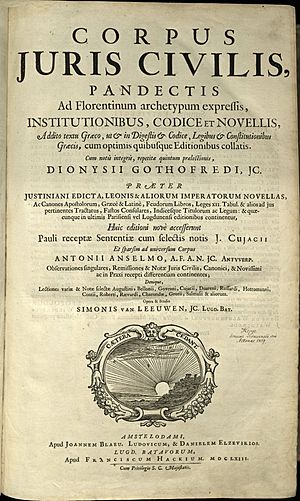Corpus Juris Civilis facts for kids
The Corpus Iuris Civilis (say "CORE-pus YOO-ris SIV-ih-lis") is a huge collection of laws from Ancient Rome. Think of it as a giant rulebook for how people lived and dealt with each other in the Roman Empire. It was put together in the 6th century by order of a very important emperor named Justinian.
What is the Corpus Iuris Civilis?
After the mighty Roman Empire fell, this collection of laws was mostly forgotten for a long time. But then, around the 11th century, people in Europe found it again! During the Middle Ages, the Corpus Iuris Civilis became a super important source of ideas for civil law in many European countries. It helped shape how laws were made and understood for centuries.
Parts of the Corpus Iuris Civilis
The Corpus Iuris Civilis is actually made up of several different parts:
- Institutiones Iustiniani: This part was like a textbook. It was created to help students learn about Roman law. It's a bit like a beginner's guide to the legal system.
- Digest: This was a massive summary of all the important Roman laws that were still in use at the time. It collected ideas and rulings from many famous Roman legal experts.
- Codex Iustinianus: This section was a collection of older laws and rules that Emperor Justinian had gathered. It included laws from as far back as the 2nd century that were still considered valid.
- Novellae: These were the "new laws." They were fresh laws made by Emperor Justinian himself after the main collection was finished. Most of these new laws were written in Ancient Greek, though there was a Latin version too.
See also
 In Spanish: Corpus iuris civilis para niños
In Spanish: Corpus iuris civilis para niños


